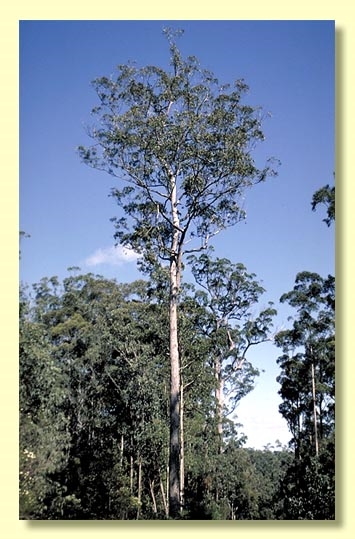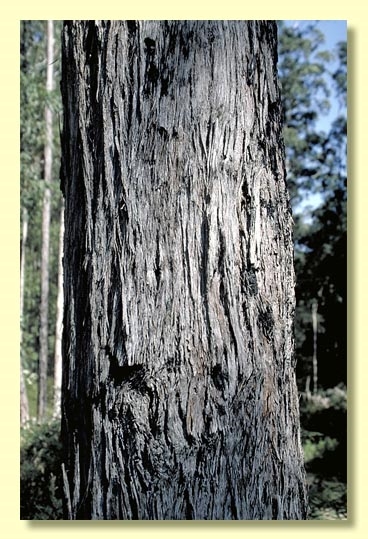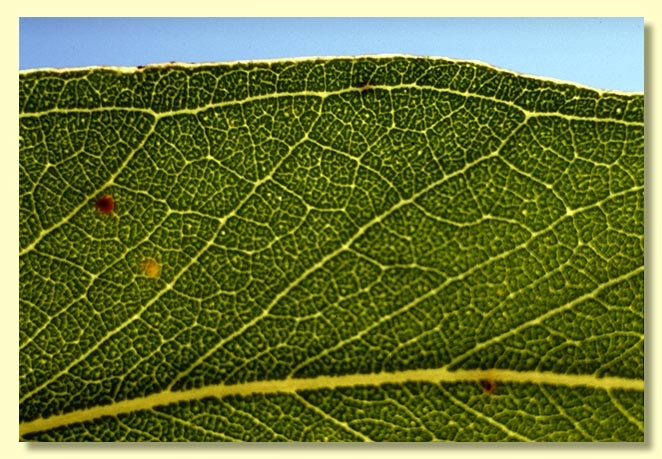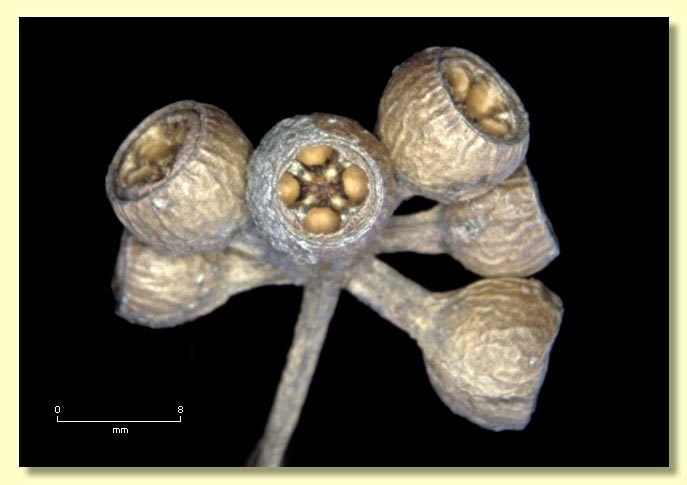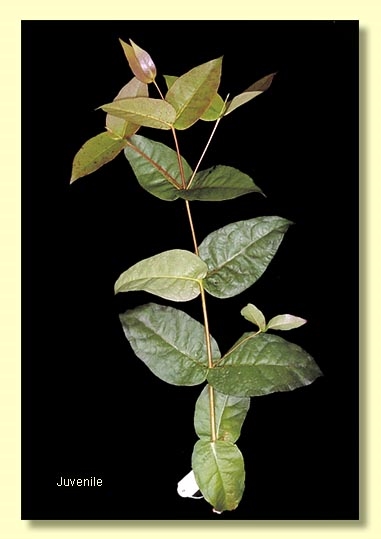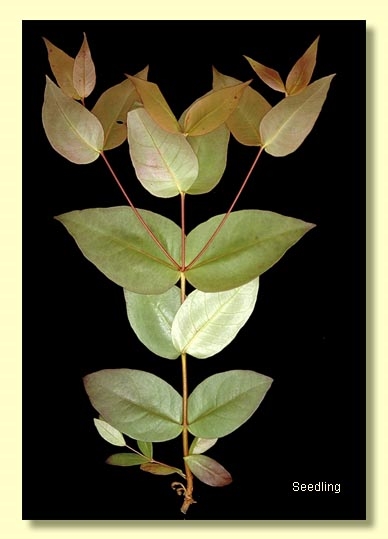Euclid - Online edition
Eucalyptus umbra
Eucalyptus | Eucalyptus | Amentum
T: Spit Road, Mosmans Bay, NSW, 24 Sept. 1982, R.T.Baker s.n.; lecto: NSW, fide S.T.Blake, Proc. Roy. Soc. Queensland 69: 86 (1958); isolecto: K.
Bark rough to small branches, stringy or fibrous, grey or grey-brown.
Juvenile growth (coppice or field seedlings to 50 cm): stem rounded in cross-section; juvenile leaves sessile and opposite for at least 10 to 13 nodes, held horizontally, broadly ovate to lanceolate, 8–20 cm long, 3.5–10 cm wide, amplexicaul, discolorous, green, eventually becoming petiolate, lanceolate, concolorous and held vertically, remaining green.
Adult leaves alternate, petiole 1–2 cm long; blade lanceolate to falcate, 6–18 cm long, 1.5–4.5 cm wide, base tapering to petiole, concolorous, glossy or dull, green, side-veins usually greater than 45° to midrib, densely to very densely reticulate, intramarginal vein parallel to and remote from margin, oil glands island, intersectional or obscure.
Inflorescence terminal panicles, or axillary unbranched, peduncles 0.6–2 cm long, buds 7 to ?15 per umbel, pedicels 0.3–0.7 cm long. Mature buds ovoid (0.6 cm long, 0.3–0.4 cm wide), green to yellow, scar absent, operculum conical to beaked, stamens irregularly flexed, anthers reniform to cordate, versatile, dorsifixed, dehiscing by confluent slits, style long, stigma tapered, locules 3 to 5, the placentae each with 2 vertical ovule rows. Flowers white.
Fruit on pedicels 0.2–0.8 cm long, cup-shaped to hemispherical, 0.3–0.7 cm long, 0.6–1 cm wide, disc broad, raised-convex, level or only slightly descending, valves 3 to 5, near rim level or enclosed.
Seeds brown, 1–2.5 mm long, pyramidal or obliquely pyramidal, dorsal surface usually smooth, hilum terminal.
Cultivated seedlings (measured at ca node 10): cotyledons reniform; stems rounded in cross-section; leaves opposite for at least 13 nodes, sessile, ovate, 8–12.5 cm long, 3.5–8 cm wide, base amplexicaul, discolorous, darker green and glossy above, paler beneath.
Flowering has been recorded in February, September, October, November and December.
A small to medium-sized forest tree endemic to New South Wales and of largely coastal distribution north from Sydney to Grafton usually on level to elevated sites of shallow sand over sandstone. Eucalyptus umbra has rough bark throughout, concolorous thick-textured crown leaves with densely reticulate venation, large broadly ovate juvenile leaves that soon become alternate, ovoid buds and flat-topped more or less hemispherical fruit.
Eucalyptus umbra can be distinguished from any stringybark species by the densely reticulate venation of the adult leaves. All stringybarks have sparsely reticulate venation; a quick inspection of fresh adult leaves against strong sunlight will be informative. In addition stringybarks have furrowed bark with much longer "stringy" fibres, thicker-walled fruit with prominent disc and juvenile leaves that are scabrid/hairy at the lower nodes at least.
Eucalyptus consideniana and E. piperita both differ from E. umbra in having juvenile leaves that are petiolate and alternate. Eucalyptus consideniana also has sparsely reticulate adult leaves and barrel-shaped to obconical fruit whilst E. piperita has somewhat similar adult leaf venation to E. umbra but has barrel-shaped to urceolate fruit. Both species occur in dry sclerophyll forest but no further north than about the latitude of Buladelah in central coastal New South Wales.
There are four other species of white mahogany occurring within or adjacent to the natural range of E. umbra. The widespread tall tree E. acmenoides occurs in wetter forests within this range, and differs from E. umbra mainly in its much thinner-textured adult leaves that are always distinctly discolorous, i.e. are much paler on the underside than the upperside (even when dried out).
The three other white mahogany species likely to be confused all have concolorous leaves. The more inland-dwelling E. apothalassica has smaller, narrower fruit often with a descending or concealed disc and narrower juvenile leaves that remain opposite for many more nodes on coppice growth. E. psammitica, a species of dry subcoastal sites north of Grafton and south of Brisbane, has longer and more globose fruit than E. umbra, and narrower juvenile leaves that remain opposite on knee-high coppice. The troublesome E. carnea, which occurs on dry sites on subcoastal hills from Newcastle to Gympie, is mainly distinguished from E. umbra on fruit features, having a narrower disc to the fruit and is more variable in placement of the disc (concealed, descending or easily visible and more or less flat, never having the broad disc and flat-topped fruit of E. umbra). Field guides and floras often state that the adult leaves of E. carnea are blue-green and those of E. umbra are green, but we doubt the consistency of this.
The Queensland endemic coastal species of white mahogany, E. latisinensis differs from E. umbra only in having slightly narrower juvenile leaves (though with overlap in dimensions), but becomes alternate even earlier than in E. umbra or E. carnea, with some field coppice alternate and shortly petiolate from node two.
MORE ABOUT WHITE MAHOGANIES

